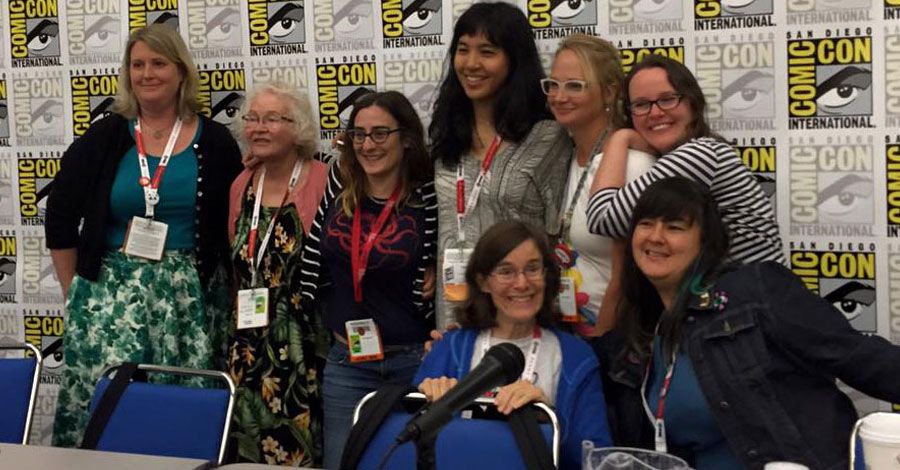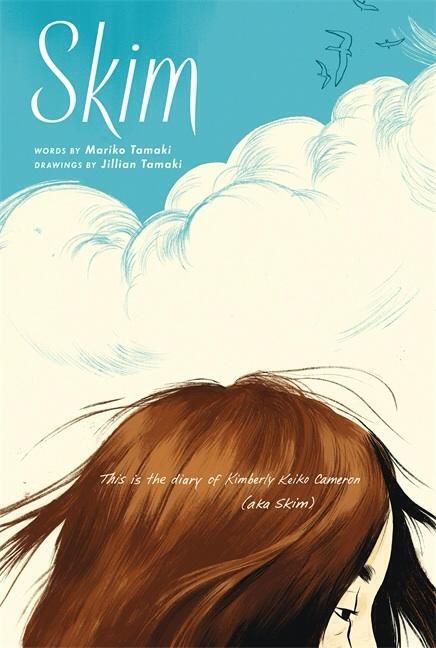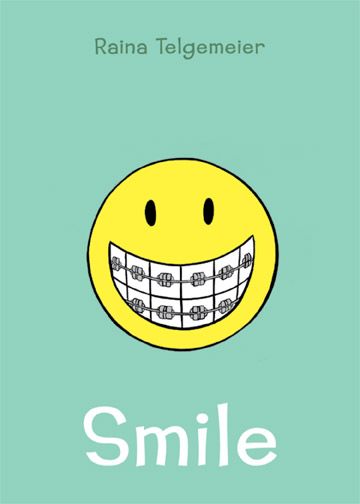When a group of all-star comics creators -- some of whom are fresh off of a 2015 Eisner Award win -- assembles for a panel to discuss the state of women in comics, the best thing to do is show up early. Although it was among the first Comic-Con International panels on Sunday morning, the conference room was filled with fans eager to hear words of wisdom from some of the best in the business. Trina Robbins, Cece Bell, Cecil Castellucci, Jenni Holm, Raina Telgemeier and Jillian and Mariko Tamaki gathered for a candid discussion on their experiences as comics readers and creators, as well as their hopes for the future of diversity in comics.
Moderated by Eva Volin of the Alameda Free Library, the panel began by discussing everyone's path to discovering comics.
Robbins remembers enjoying comics from the time she could read. "In those days in wasn't unusual for girls to read comics," she said. "There were lots of things for girls to read. From the moment I was reading comics, they made an impact on me."
SDCC: Raina Telgemeier Brings a "Smile" to Fans' Faces
Bell came to comics through her older brother's collection, including "Mad Magazine" and "National Lampoon," but it wasn't until she read Telgemeier's "Smile" that she saw a way for her to tell her own stories in comics.
Castellucci began reading comics as a youngster, having fallen in love with Adam West on "Batman," and considered her brother's bookshelf and pull box to be her own, reading "West Coast Avengers" and "Spider-Man." Although she couldn't draw, she still longed to create comics. However, it wasn't until she read "Deadenders" by Ed Brubaker that she saw a path for herself and joined with Editor Shelly Bond as DC's Minx imprint began.
Jillian's first contact with comic books was the grocery store variety, consisting of "Archie" and "Mad Magazine" as well as Sunday comics. She discovered Drawn & Quarterly and alternative comics in college, where she realized she could use the medium to tell emotional, real stories.
Telgemeier was about comic strips all the way, beginning with "Foxtrot" and "Luann" at age nine, and progressing into "For Better or Worse," which spoke to her in a way that influences her art to this day.
Mariko shared that most of her memories of comics as a kid were "intensely sexist moments from 'Betty and Veronica.'" Although she loved reading comics, she found the stories so "heinously circular" that even as a child she rejected it. Later in life she found "Sandman," which reignited her spark with comics. "I related to Death, obviously," she said smiling.
Volin asked Robbins, who has a long history in comics and has been studying women in the industry, for her perspective on how much progress had been made with regard to women being represented in the industry over the years.
"We've come incredibly far," Robbins said. "There are more women drawing comics than ever before. I started researching women who create comics, because when the guys write books about comics they write about Jack Kirby and Hulk. They don't see all the incredible women that have been in the industry. There is a long history of women creating comics. During World War II, when the men went off to fight the war, as in every other industry, women took their places. That was a high point in women drawing comic books. It was after the war that everything started going downhill. Women were literally sent to the kitchen. They were encouraged to marry the boys who came home, raise a family in their frilly aprons. It really wasn't until the late '90s that its been picking up again for women. I have no idea how many women are in the industry, but more than ever before," she finished, as the audience applauded.
Robbins mentioned that if there is a perception about boys and girls reading differently, the environment of comics shops needed to be examined. "During the '80s and '90s, any girl that walked in was either stared at or completely ignored, but one way or another, she didn't feel invited in. It didn't help that there was some life-sized babe pinup in the window. The comics they carried were not what I call girl-friendly. The editors and publishers could say girls don't read comics, but what they didn't understand was that they weren't making comics girls like to read!"
"If you're always the object or the dupe in a comic, why would you be interested?" Mariko asked. "Why would you walk into a comic store where the empowered people are mostly men?"
Mariko said that the pushback on social media against mistreatment in comics stores and representation in comics has gone a long way toward overcoming sexism. Additionally, we now have organizations like The Valkyries, an all-lady group of comics retailers, committed to making everyone feel welcome in comic stores.
Castellucci mentioned another group of powerful advocates for making comics available fore everyone -- librarians. "Something that has enormously changed are libraries curating graphic novel sections and books stores cross shelving comics in the YA section."
That brought the panelists to the placement and availability of comics and graphic novels for young readers. Without librarians and informed retailers, how could kids find good books? And once they did, what about parental interference? Panelists noted that some parents still showed strong favoritism in certain books being only for boys while others are only for girls. Volin asked the panelists what suggestions they had for helping overcome that bias.
"Kids will just read a good book, and we should trust them to pick up the book they want to read," Castellucci answered succinctly.
Telgemeier had a middle-aged man do that very thing to her the previous day. "He spent five minutes telling me how great 'Smile' was, but refused to read 'The Baby-Sitters Club,'" she said. "I challenged him for about five minutes before I was exhausted. It was the one time this entire week. This week has been amazing for ladies in comics. We rocked it at the Eisners, and I've been feeling like Im on top of the world!"
Mariko shared that she felt the audience for her books was more complex than basic gender dynamics, noting that creators and publishers needed to shift with the times and not market everything as just being for one gender.
For Robbins, librarians had always been a powerful resource. "They've wanted graphic novels that have gender equity. The librarian is my friend and they really want these kinds of books."
In 2008, Jillian went to a librarian convention and saw that while some librarians weren't well versed in graphic novels, they saw a passion in their young patrons for reading them, and they were committed to making an effort to understand and educate themselves on comics. "They didn't have preconceived notions of what a comic could be, they were just encountering good stories that people were connecting with."
Jillian explained that while "Skim" featured a queer protagonist, she wants to work on a variety of characters and not become a one-note artist. While she was happy the sexual identities, racial and body diversity in her work struck a chord with people, she wondered if she risked being pigeonholed. "They expect you to be representative of all Asian people in North America," she said. "I want to keep texture in the books and not become a spokesperson for a certain type of girl."
"You don't want to have conversations that are only about diversity," Mariko added. "You want to accept that diversity is something that's important to me as someone who is internally and externally diverse, but it's not the main focus of anything we do. We need to move past the idea of tokenism."
Castellucci agreed. "All books don't have to be everything to every person."
Volin opened the panel up for audience questions. One fan was alarmed to find out that three of the panelists -- the Tamakis and Telgemeier -- have all had their books challenged for questionable content. How did that feel?
Mariko said that as a creator, she doesn't care about her work being challenged. However, as a fan of books, she felt that any books being banned was a huge issue. "I wouldn't want a book someone had a problem with banned from my library."
Telgemeier agreed, saying that she was frustrated with how easily things were taken out of context. Due to the visual medium of comics, it's easy to look at an image without the accompanying story and feel that it's inappropriate. "It's a backwards step, and I think we're all sort of interested in forward momentum."
The panelists mentioned The Comic Book Legal Defense Fund as an excellent resource for creators that needed to combat a challenge, or for educators to utilize as an empowerment tool to use books in the classroom setting. They noted the resources the CBLDF offers and directed anyone interested in learning more about challenged books to visit the website. (http://cbldf.org)
Finally, the moment many of the panel's young attendees had been waitng for arrived: what advise did the panelists have for young girls that wanted to make comics?
"Keep making comics," Mariko answered. "Don't ever sleep. Watch a lot of TV, read a lot of books, and, uh... eat whatever you want!"



